Adwords Keyword Research

Keyword selection might look like an easy step but this is just an
illusion. Yes, you can throw 5, 10, 100, or 500 keywords you deem fit
but this will only drain your pocket, even if some of the keywords by
chance bring some cash. Needless to say, this is not the right
approach.
1. Keyword Tool
What you must do instead, is use some keyword research tools.
Google AdWords offers two such tools � Keyword
Tool and Traffic
Estimator. In your AdWords account, open the Tools & Analysis
menu and there you will find them both, together with some other
tools we'll be discussing later.
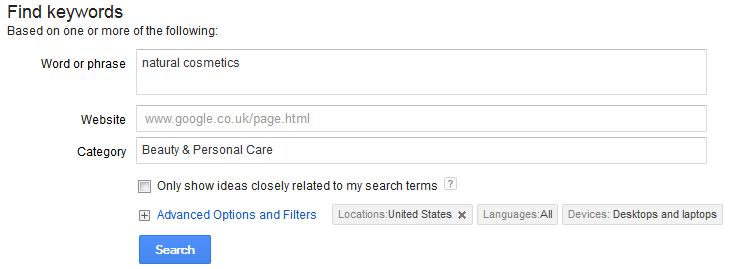
For now, take the description we made in Chapter 3 and go to the
Keyword Tool. Type in some keywords you suppose your customers will
be searching for. For instance, for the natural cosmetics example
from the previous chapter, try with the very broad "natural
cosmetics" first.
In the Keyword Tool, under Category, pick Beauty & Personal
Care, or All Categories. Just pay attention you have selected an
appropriate category because otherwise the results you will get will
be kind of misleading. Also, check if you are searching the
locations, languages, and devices you want.
With such a broad term as �natural cosmetics�, you will likely
get hundreds of keywords and keyword groups. Get your client
description and pick only the keywords that you think fit it best. Of
course, this is very subjective but use your sound judgment. If a
keyword suggestion seems somehow relevant, don't include it for now �
stick with the very relevant only.
If you managed to limit your list to 20-30 very relevant keywords,
this is fine. For each keyword, Google gives you some traffic
estimates for global and local monthly searches and these are fine
for now to get an idea if it's a high-volume search word or not.
2. Traffic Estimator
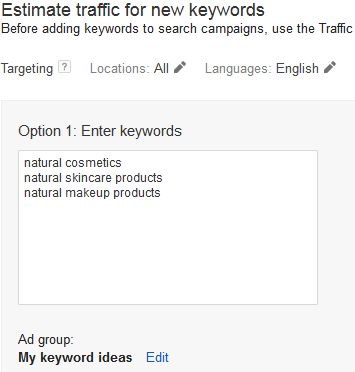
If you are interested in how much traffic you could expect for a
particular bid amount, use the Traffic Estimator (accessible from the
Tools & Analysis menu) to get an idea. This tool shows how many
clicks and impressions you can get for your target bid amount.
The rule here is simple � the highest the bid, the more
profitable the keyword. You might be tempted to start with the
cheapest keywords first, so that you don't lose money but the winning
approach is just the opposite. The keywords with the highest bid
bring more money per click and this is why they are priced so high.
Of course, don't forget about keyword relevance. Combine both
criteria and pick keywords that have high max bids and are relevant.
For now this is the best you can do. Your keyword list should be 5 to
10 words but since its quality, not quantity, if you have more or
fewer than this, there is nothing to worry about.
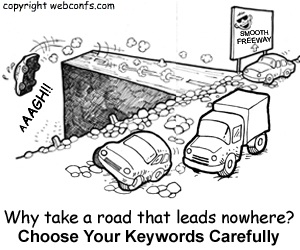
3. Create the Right Ad Groups
While ad groups aren't directly related to keyword selection, they
are related to keywords and this is why we need to make some
clarifications about them.
Ad groups are units that consist of multiple keywords. The way you
group these keywords can make or break your campaign. The basic rule
to follow is that in each group you need to focus on one type of
product or service.
For instance, if you want to promote natural skincare products and
natural makeup products, these are two separate groups and you
shouldn't be mixing them into one.
Both natural skincare and makeup are of interest to a client who
loves natural cosmetics but basically these products serve a
different need. If you mix skincare with makeup offers, people who
are looking for skincare and don't use makeup, won't buy natural
makeup from you, even if you kindly take them to your landing makeup
page. Instead, you need to have two ad groups that use different
keywords and lead to two different pages � one for skincare
products and one for makeup.
For skincare products, you could use keywords, such as �natural
skincare products", "organic skincare", "best natural
skincare", etc. but don't use "natural lipstick" for example
because it doesn't have much to do with skincare.
4. Get Rid of Negative Keywords
While you are still looking for which keywords to use, think about
the keywords you wouldn't like to use. The so-called negative
keywords are keywords that are very similar to your keywords but
that you want to exclude because they bring only clicks but no
conversions.
The most common negative keywords are "free" and "cheap"
but there are many others. So, if you are not selling cheap natural
skincare and don't want to get visitors who are looking for cheap
stuff, add "free" and "cheap" to the list of negative
keywords.
If you are selling only ladies stuff, you might want to add "kid",
"men", and "baby" to the list of negative keywords. You get
the idea � any keyword that doesn't fit your products must go.
5. The Peel & Stick Strategy
The Peel & Stick Strategy is one of the most brilliant
approaches to maximizing CTR. The principle is simple: look at how
your ad groups are performing, pick a high traffic keyword, take it
out (or peel it out) of the group and put it (or stick it) into a new
ad group. When you move the keyword to a new group, use the keyword
in the headline and just watch how your CTR goes up.
The Peel & Stick strategy works because ads with the keyword
in the headline tend to get more clicks. When the high traffic
keyword is mixed with other keywords in the same group, this
influences it badly. So, if you find a keyword with a lot of views
but clicks below what you think it has a potential for, most likely
this keyword is a candidate for the peel & stick approach.
For instance, if our keywords for our skincare products are
"natural skincare products", "organic skincare", "best
natural skincare", "aloe vera skincare" and you notice that
"aloe vera skincare" gets lots of views but doesn't have a good
CTR, you should try peeling it out of the group and sticking it to a
new ad group where you have "aloe vera skincare" in the title.
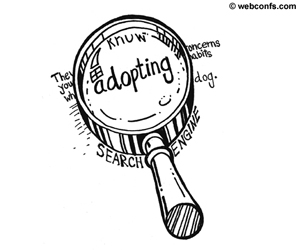
6. Broad Match vs Phrase Match vs Exact Match
When you pick keywords, you have the options to use either broad
match, or phrase match, or exact match. Obviously, exact match is
best because this means that the user has searched for exactly the
term you have bid on. For instance, if we continue the natural
skincare example, if you bid on "natural skincare", only users
searching for "natural skincare" (or very small variations of it)
will be shown the ad.
With broad match you will get more clicks but these are less
targeted. Broad match includes not only the keyword itself but also
synonyms, related searches, misspellings, etc., not all of which are
relevant. For instance, a possible broad match for "natural
skincare" is "men skincare products", which is everything but
relevant, if you are selling ladies' skincare only.
Phrase match falls somewhere in between broad match and exact
match. With phrase match, the exact phrase plus some variations are
matched. Example: "natural skincare" could be matched with
"natural skincare products" or "natural skincare teens"
because they all have "natural skincare" but use variations which
aren't necessarily useful � if you don't sell teen skincare,
getting clicks for "natural skincare teens" is next to useless.
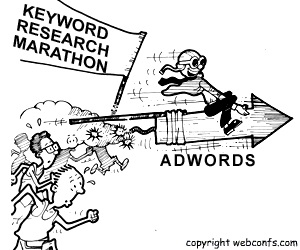
7. Use Long Tail Keywords
Long tail keywords might not get many searches but this is not a
reason to ignore them. Long tail keywords are more targeted, which
means that even if you get just a couple of searches, these searches
are far more relevant than general high-volume searches.
In other words, if you use keywords, such as "aloe vera
skincare", "organic skincare", "best natural skincare",
don't forget about less popular keywords, such as "aloe vera
skincare night cream", "organic skincare teen acne", etc.
8. No Generic Keywords
Probably you have figured it on your own by now but since this is
way to important to skip, let's warn you explicitly that generic
keywords are to be avoided.
As a rule, generic keywords rarely convert well � i.e. if you
are selling organic skincare, don't bid on 'skincare', or even worse,
on 'cosmetics' because they are not closely related to your products.
As a result, you will get tons of clicks (and spend tons of money on
them) and make little to no profit.
9. Perform Regular Audits
If you think that once you set you keywords, you are done, this
isn't so. In fact, audits on how keywords perform take much more time
and effort than coming with a keyword list.
You've got to do it, though, because even keywords that once used
to perform well could bring no more clicks and conversions and you
have to remove them. You also need to watch for keywords that get a
good amount of traffic but haven't reached their click potential and
once you identify such keywords, apply the Peel
& Stick strategy to them.
The purpose of this chapter was to teach you how to deal with
keywords. I can't stress how important keywords are. If you choose
the wrong keywords, or the wrong bid amounts on the right keywords,
this will take you nowhere, even if your ad copy rocks. So, do your
keyword research and only after that move to writing the copy that
sells.
|




